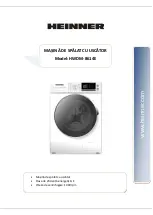
5
A measured amount of rinse-aid is released during the final rinse. As with detergent, the amount
of rinse-aid needed for your dishes depends on the hardness of the water in your area. Too much
rinse-aid can result in lather of foaming and cause cloudiness or steaks on your dishes. If the
water in your area is very soft, you may not need rinse-aid. If you do, you can dilute the rinse-aid
with an equal amount of water.
The rinse-aid dispenser has six or four settings. Always start with the dispenser set on " 2 ". If
spots and poor drying are problems, increase the amount of rinse aid dispensed by removing the
dispenser lid and rotating the dial to "3". If the dishes still are not drying properly or are spotted,
adjust the dial to the next higher number until your dishes are spot-free. We suggest you
to set on "4" .(Factory value is "4".)
If there is no rinse-aid warning light in the control panel, you can judge the amount of rinse-aid by the color of the optical level
indicator "D" located next to the cap. When the rinse-aid container is full, the whole indicator will be dark .As the rinse-aid
diminishes, the size of the dark dot decreases. You should never let the rinse aid get below 1 / 4 full.
As the rinse aid diminishes, the size of the black dot on the rinse
aid level indicator changes, as illustrated below.
Full
3 / 4 full
1 / 2 full
1 / 4 full - Should refill to eliminate spotting
Empty
To open the dispenser, turn the cap to the "open" (left)
arrow and lift it out.
Pour in rinse -aid into the container is fill (approx . 140 ml) ,
Being careful not to overfill.
Replace the cap by inserting it aligned with "open" arrow
and turning it to the closed (right) arrow.
The rinse aid is released during the final rinse to prevent water
from forming droplets on your dishes that can leave spots and
streaks. It also improves drying performance by allowing water
to "sheet" off the dishes.
Your dishwashers are designed to use liquid rinse aid. The
rinse aid dispenser is located inside the door next to the
detergent dispenser.
Be careful not to overfill the dispenser, because this could
cause oversudsing. Wipe away any spills with a damp cloth.
Don't forget to replace the cap before you close the dishwasher
door.
If you have soft water, you may not need rinse aid for it may
cause a white film to develop on your dishes.
Follow the rinse-aid manufactory's recommendations
on rinse-aid.
D
NB: We do not recommend the use of detergent tablets that
contain rinse aid balls, due to the possibility of over foaming
and subsequent electrical fault of the dishwasher.




































